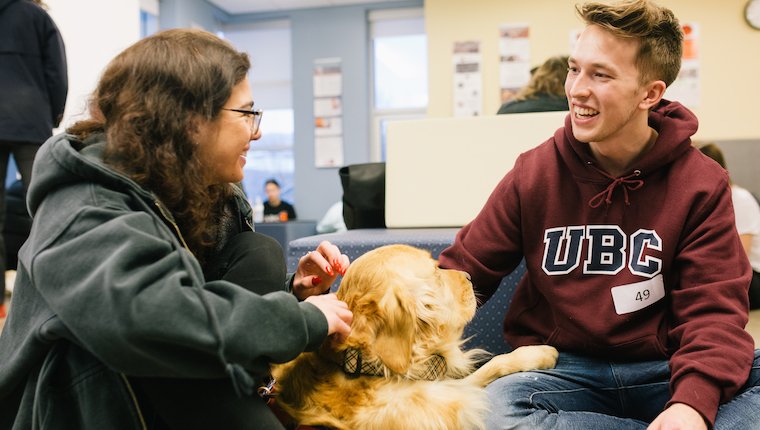- September 10, 2022
- No Comment
- 6 minutes read
Cuddling Dogs Improves Student Life at Canadian University – DogTime

(Photo Credit: Adam Lauze)
Cuddling dogs — tummy rubs, ear scritches, and nuzzles — increases wellbeing, according to new research from the University of British Columbia Okanagan.
“Dogs are social lubricants. They glue people together who otherwise wouldn’t be connected,” lead author and UBC associate professor John-Tyler Binfet told DogTime.
Advertisement
The research evaluated the effects of dog therapy on students. It found that physical contact with canine support animals is key to reducing stress.
“We have 60 dogs on campus that help students who are homesick and/or stressed out,” said Binfet. He is also the founder and director of the popular Building Academic Retention through K-9’s (B.A.R.K) program at UBC Okanagan. On its website, B.A.R.K. explains that it is designed to support the emotional well-being of university students grappling with challenges around homesickness, social isolation, and integration into the university community. B.A.R.K. programming consists of both intervention studies and community drop-in services. B.A.R.K. research has been featured in WebMD, Psychology Today, and the American Kennel Club.
The school’s education program, in coordination with UBCO’s dog therapy program for students, conducted the latest research. Binfet and his team assessed the well-being of 284 undergraduate students based on surveys before and after visiting a pup through the program.
“There have been a number of studies that have found canine-assisted interventions significantly improve participants’ wellbeing, but there has been little research into what interactions provide the greatest benefits. We knew that spending time with therapy dogs is beneficial, but we didn’t know why,” Binfet told CTV News.
Binfet told DogTime that dog visitations with the program are increasingly popular across North America and Europe.
“We are celebrating our tenth year with dog handler teams who are on campus once or twice a week to help students. Some students choose this campus specifically because of the B.A.R.K. program. Parents call and say their kid wants to come here,” Binfet said.
One of those kids is Amelia Willcox. She told DogTime, “I’m now in my fifth year with B.A.R.K., and the program has improved my mental health each year. School can be difficult, but B.A.R.K. gave me a place where I feel at home and safe. And it’s given me a sense of purpose — helping other people. A big part of the program is drop-in sessions: homesick students love the dogs, and it’s also somewhere to wind down and make friends.”
Willcox with Skeena, a Brown Labrador. (Photo Credit: Freya Green)
Willcox has a dog at home in Vancouver, so she knows firsthand what it’s like for students to miss their family pooch. She adds that the program also provides a “great place to de-stress.”
She explains why stress is pervasive on campus, more so now than ever before, “There is more competition for post-grad school, and you need high grades to get into programs. Some students are on scholarships, and it’s so expensive to travel. They don’t go home as much.”
Binfet concurs, “I often receive calls from parents that thank us for the program and that when their kids come home over winter or summer break all they’re talking about is how much they love the B.A.R.K. program.”
There are about 20 volunteers in the program at UBC Okanagan. Willcox says she is definitely the senior volunteer. She thinks programs like B.A.R.K. will bloom, and the dogs also help make new friends.
She explains, “For instance, students in the library recognize me and ask how they can get involved. First, they have to apply to find out if they are a good fit. It’s quite a commitment, and it helps to have a love for dogs. We love having a diverse range of personalities from all over the world. and it’s wonderful to see them loving the dogs.”
“We let the kids determine how long they want to stay with the dogs and handlers — the average time is 32 minutes. But even visiting once a month chips away at their stress level. Dogs are also known as social catalysts,” says Binfet.
Amelia details a typical session.
“It’s Friday afternoon. Two volunteers have sign-in/out forms. Handlers with their dogs must pass an assessment at the beginning of the school year. There are 10 teams: each team might have one or two dogs with one or two handlers. Their stations, including a dog bed, are spread out in the room. Students roam around and talk to handlers and pet the dogs. However, they want to interact. There is no specific structure. During my first year I approached the chattiest person and other times I went to the station without any other students. Often, students gravitate to their favorite dog. Lots of students have a fave based on the type of dog they have at home. It’s great to see positive reactions like tail wagging, and it’s a great social outlet. Talking to handlers about the dogs makes social contact easier.”
And then there’s the cuddling, of course.

